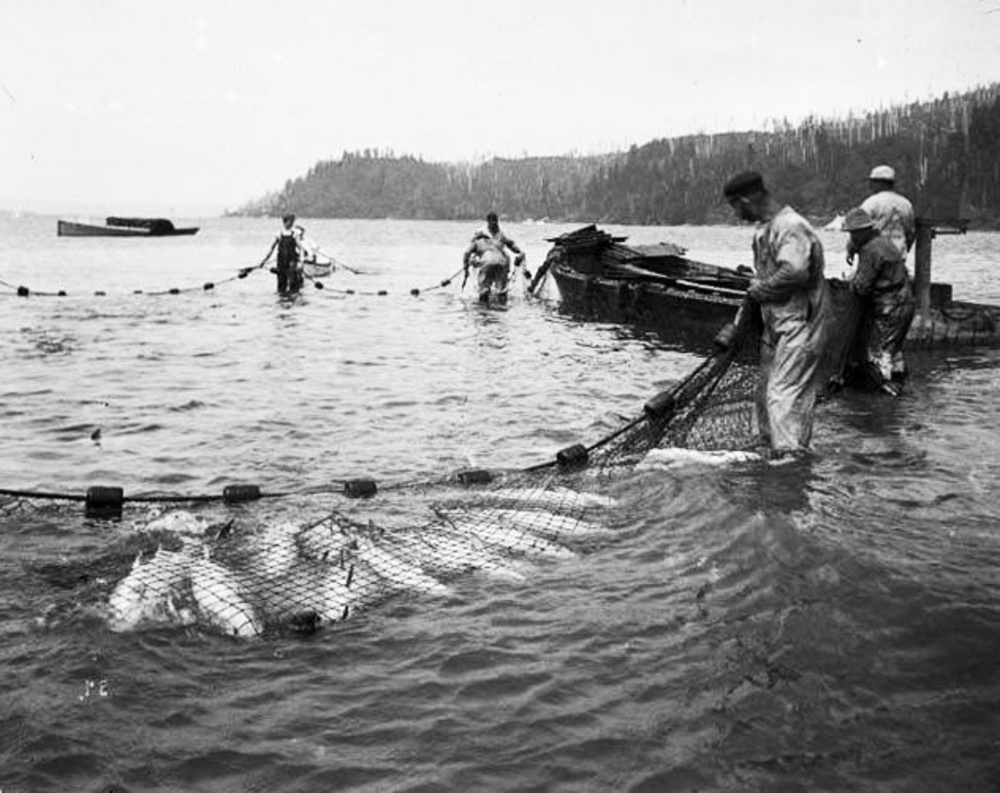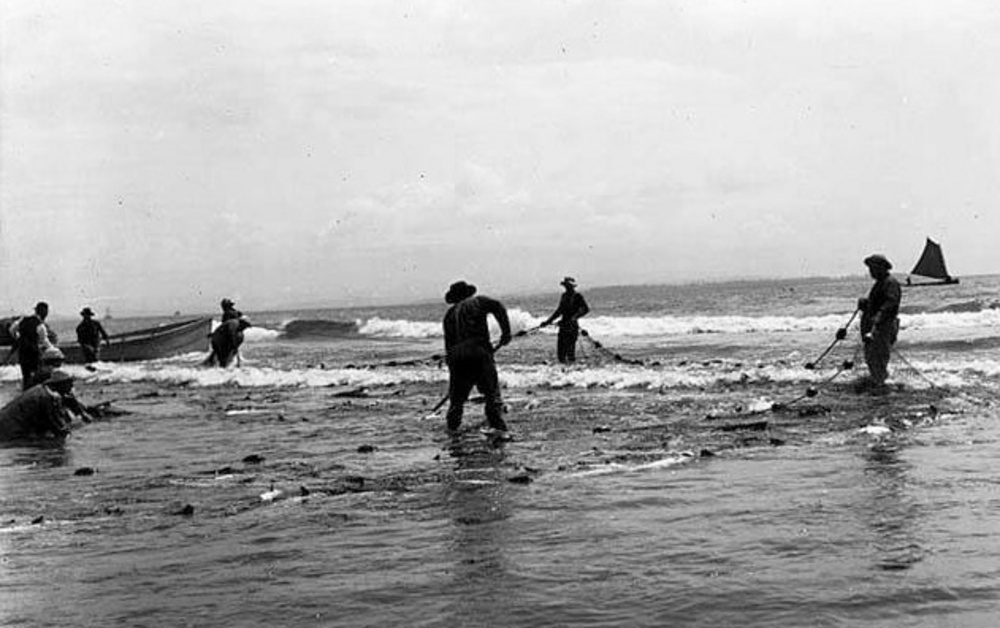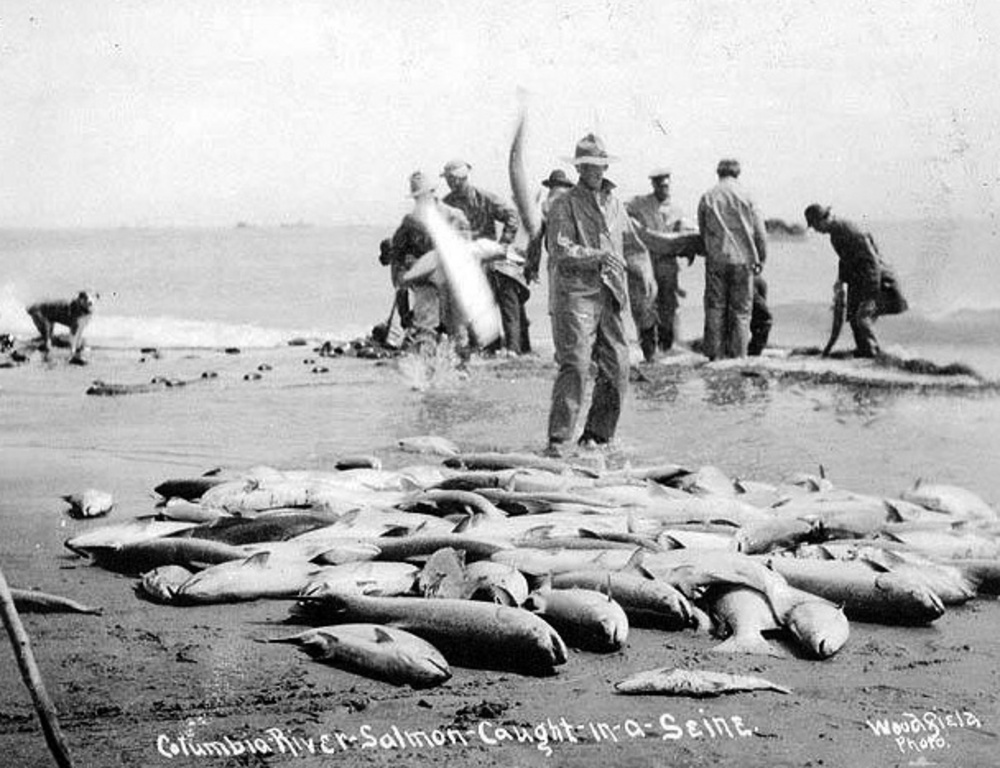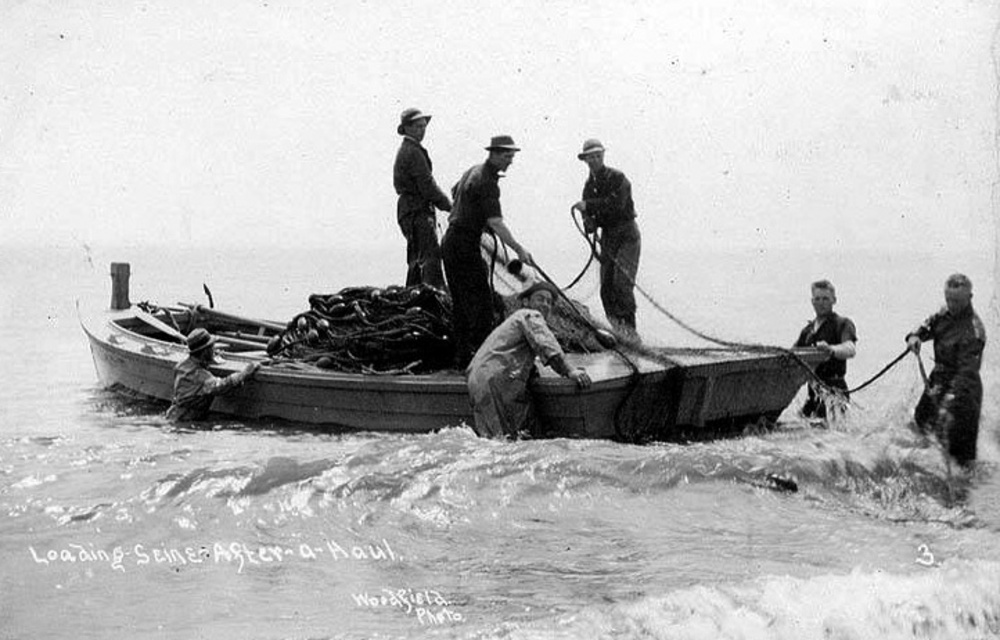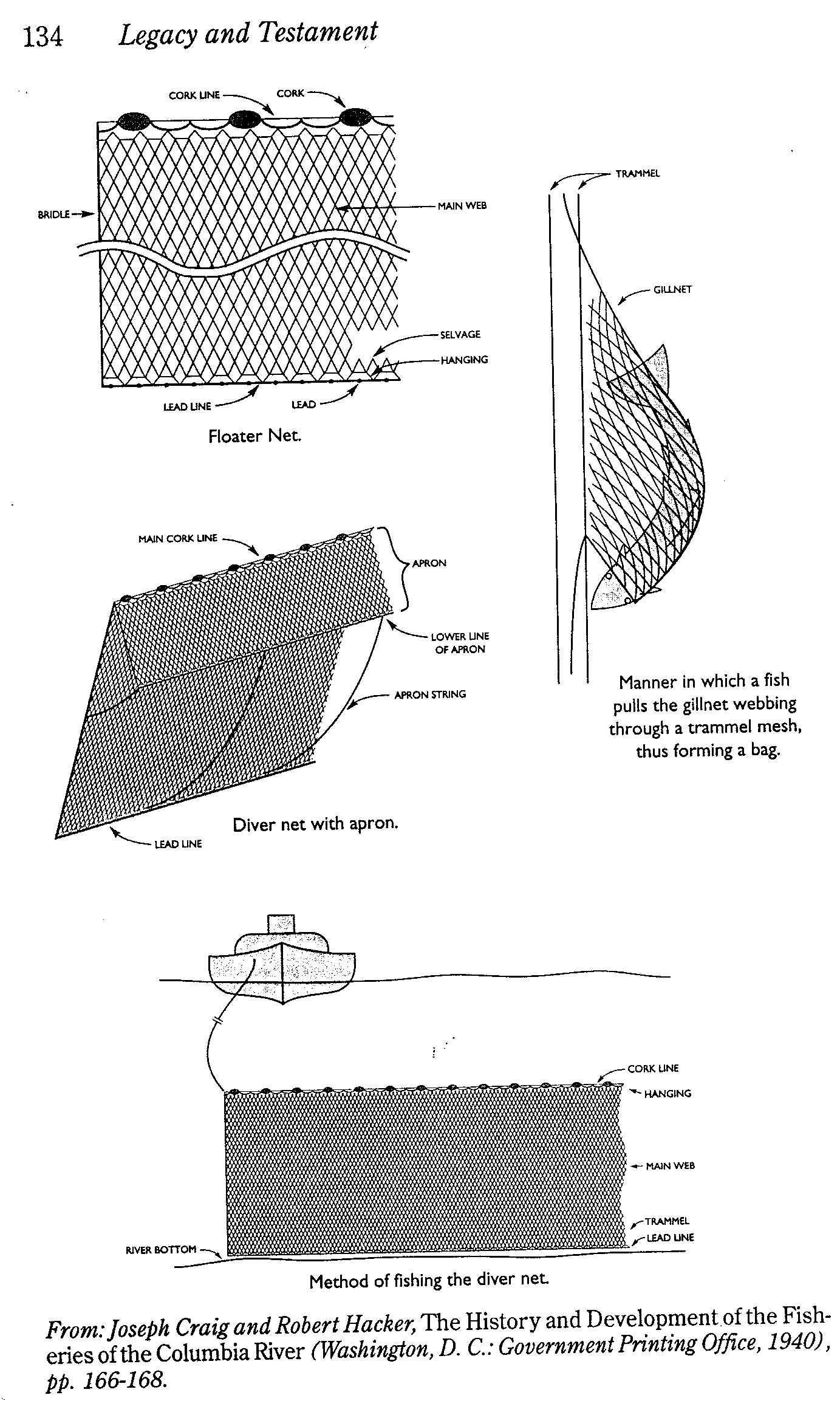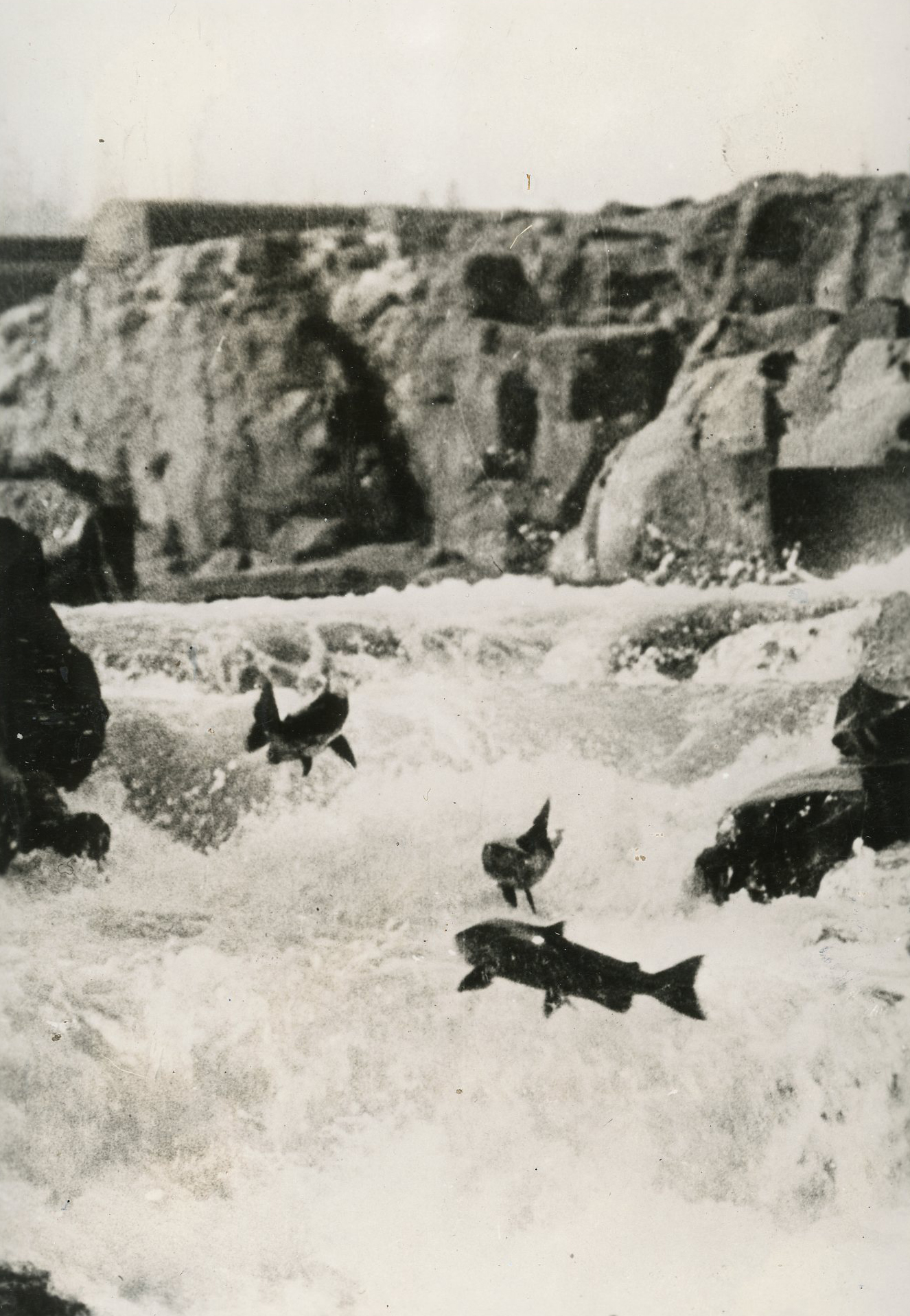For much of their fishing history in Oregon, Native Americans used hand-operated haul seines. A fish seine is a horizontal net that has floats holding the top line of the net at the water's surface. The net extends down in the water due to weights placed on the net's bottom line. The weighted line can then be pulled, so that the net acts like a purse.
Indian seines were made from wild grasses or fiber from spruce roots. The bottom line of the net's webbing had stones to weight the net, and cedar sticks served to float the top line. The movement of the cedar sticks caused by agitated fish helped keep the salmon from escaping. Seines were fished on smooth bottoms where salmon congregated. Haul seines also caught other fish, and new settlers in the region picked up the technique.
Seines can catch many schooling species, and they are most noted in the Columbia River for catching salmon. The procedure was to sweep nets during ebb tide from upstream to down, with the net anchored at the beach upstream. A boat then carried the net out and around salmon migrating upstream. In 1852, P.J. McGowan bought salmon (for the trade in salted salmon) from Chinook Indians who used seines, and commercial seine catches of salmon on the Columbia River are reported from 1877.
In 1895, R.D. Hume refined the technique by using horses to haul the seines. At the time, eighty-four seines were in use on the Columbia. The number increased to one hundred in the late 1920s. During their peak in the 1930s, seines took about 15 percent of the Columbia River salmon catch. A horse seine crew could employ from two to forty people and use up to seven teams of horses. Seine work was a good summer job for college students, and the crews had names denoting a crew characteristic, such as the Oregon State College Seine Crew.
Seine-caught salmon were cheaper for the canneries than fish caught using other methods, and most seining sites were owned or leased by the salmon-canning companies. Seines operated from sunup to sunset, with catches usually best near daybreak; afternoon was the poorest time. On the Columbia River, seining took place on beaches and islands, where seine sites were named (for example, Sand Island and Desdemona Sands).
Purse seines are fished from a boat that lays out the seine in a circle around a school of fish. The seine is then pursed around the school. Purse seines were very important gear on Puget Sound, and by 1905 the boats and pulling of purse seines were motorized. William Graham, from Ilwaco, Washington, operated the first purse seine on the Columbia in 1905.
Several purse seines operated through early 1922, when Oregon and Washington made it illegal to use them to catch salmon on the Columbia and outside waters. Gillnetters had complained of purse seiners taking their nets, and local fishers protested the presence of Austrians who used purse seines on the Columbia during World War I. In protest, Jens Nielsen wrote President Herbert Hoover: "and now the Austrian enemies are allowed to be here on the river, and not only take the fish belonging to us, but destroying our nets besides."
In 1948, horse and hand seines were outlawed by initiative petition in Oregon. The seines had been outlawed in Washington in 1934 because of corporate competition with independent fishing families.
-
![Seine fishing, lower Columbia River, about 1900.]()
Fishing, seine, lower Columbia R., ca. 1900, 1.
Seine fishing, lower Columbia River, about 1900. Univ. of Washington Lib., Special Coll. Div., IND0630
-
![]()
Fishers use horse-drawn seine nets, Astoria, c.1910.
Oregon Historical Society Research Library, OrgLot78_B1F2_014 -
![Hauling in fishing seine, lower Columbia River, about 1900.]()
Fishing, seine, lower Columbia R., ca. 1900, 2.
Hauling in fishing seine, lower Columbia River, about 1900. Univ. of Washington Lib., Special Coll. Div., IND0629
-
![Seine fishers with salmon, lower Columbia River.]()
Fishing, seine, lower Columbia R..
Seine fishers with salmon, lower Columbia River. Univ. of Washington Lib., Special Coll. Div., IND0090
-
![Loading a seine into a fishing boat, lower Columbia River.]()
Fishing, seine, loading boat, lower Columbia R..
Loading a seine into a fishing boat, lower Columbia River. Univ. of Washington Lib., Special Coll. Div., IND0088
Related Entries
-
![Columbia River]()
Columbia River
The River For more than ten millennia, the Columbia River has been the…
-
![Gillnet fishing]()
Gillnet fishing
A gillnet is used by fishermen throughout the world to catch various sp…
-
![Salmon]()
Salmon
The word “salmon” originally referred to Atlantic salmon (Salmo salar),…
Related Historical Records
Map This on the Oregon History WayFinder
The Oregon History Wayfinder is an interactive map that identifies significant places, people, and events in Oregon history.
Further Reading
Martin, Irene Martin, Beach of Heaven: A History of Wahkiakum County. Pullman: Washington State University Press, 1997.
Smith, Courtland L. Salmon Fishers of the Columbia. Corvallis: Oregon State University Press, 1979.
Stewart, Hilary. Indian Fishing: Early Methods on the Northwest Coast. Seattle: University of Washington Press, 1977.
Swan, James G. The Northwest Coast, or Three Years Residence in Washington Territory. New York: Harper & Brothers, 1857.

